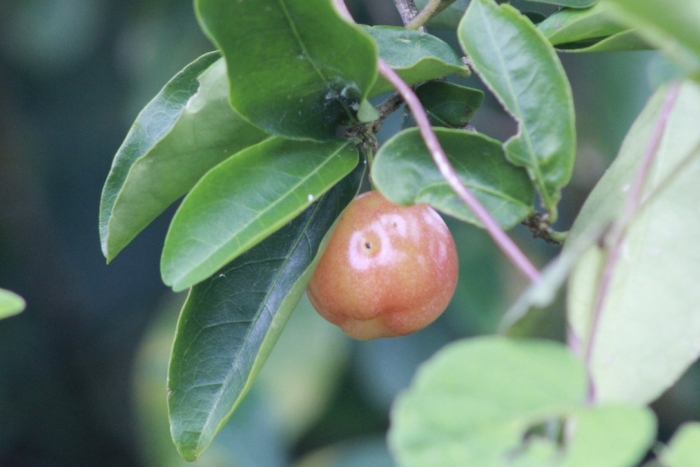Acerola Cherry
(Malpighia emarginata)
Acerola Cherry (Malpighia emarginata)
/
/

© Stephanie Tran
CC BY 4.0
Image By:
© Stephanie Tran
Recorded By:
Copyright:
CC BY 4.0
Copyright Notice:
Photo by: © Stephanie Tran | License Type: CC BY 4.0 | License URL: http://creativecommons.org/licenses/by/4.0/ | Uploader: stephtran | Publisher: iNaturalist |

























Estimated Native Range
Summary
Malpighia emarginata, commonly known as acerola cherry, Barbados cherry, or West Indian cherry, is a tropical evergreen shrub or small tree native to dry deciduous forests in South and Central America, the Caribbean, and southern Mexico. It typically grows 7-10 feet tall but can reach up to 20 feet in optimal conditions. The plant has a bushy growth form with glossy, green leaves and produces small, pink to white flowers throughout the year, with the peak flowering season from spring to early summer. The flowers are followed by bright red drupes that are notably high in vitamin C content. Acerola cherries are attractive and showy, making the plant popular in gardens and landscapes.
Acerola is valued for its nutritional fruits and is widely cultivated in tropical and subtropical regions for both its fruit and ornamental qualities. It is also used in hedges and as a potted plant. In cultivation, acerola prefers dry, well-drained, sandy soils and requires full sun exposure. It is sensitive to cold temperatures below −1°C and has shallow roots, which can make it susceptible to wind damage. The plant is relatively easy to maintain but may require protection from frost in cooler climates. Acerola can suffer from pests like aphids and fruit flies, and diseases such as leaf spot. Regular pruning can help maintain its shape and promote fruiting.CC BY-SA 4.0
Acerola is valued for its nutritional fruits and is widely cultivated in tropical and subtropical regions for both its fruit and ornamental qualities. It is also used in hedges and as a potted plant. In cultivation, acerola prefers dry, well-drained, sandy soils and requires full sun exposure. It is sensitive to cold temperatures below −1°C and has shallow roots, which can make it susceptible to wind damage. The plant is relatively easy to maintain but may require protection from frost in cooler climates. Acerola can suffer from pests like aphids and fruit flies, and diseases such as leaf spot. Regular pruning can help maintain its shape and promote fruiting.CC BY-SA 4.0
Plant Description
- Plant Type: Shrub, Tree
- Height: 20-30 feet
- Width: 15-20 feet
- Growth Rate: Slow, Moderate
- Flower Color: Pink, White
- Flowering Season: Spring, Summer
- Leaf Retention: Evergreen
Growth Requirements
- Sun: Full Sun, Part Shade
- Water: Medium
- Drainage: Medium, Fast
Common Uses
Bird Garden, Edible*Disclaimer: Easyscape's listed plant edibility is for informational use. Always verify the safety and proper identification of any plant before consumption., Low Maintenance, Potted Plant
Natural Habitat
Dry deciduous forests
Other Names
Common Names: Acerola, Wild Crepe Myrtle, Cerise D’Haiti, West Indian-Cherry, Grosella, Cherry, Shimarucu, Shimaruku
Scientific Names: , Malpighia emarginata, Malpighia berteroana, Malpighia lancifolia, Malpighia punicifolia var. lancifolia, Malpighia punicifolia var. obovata, Malpighia punicifolia var. vulgaris, Malpighia retusa,
GBIF Accepted Name: